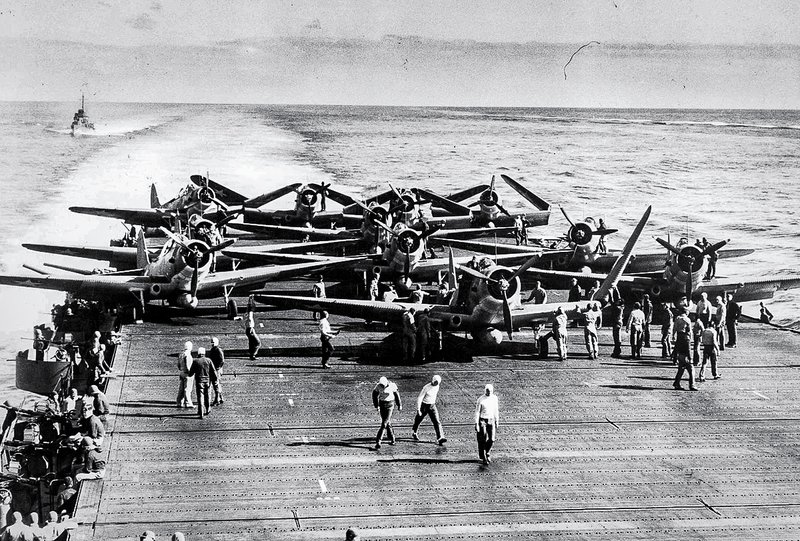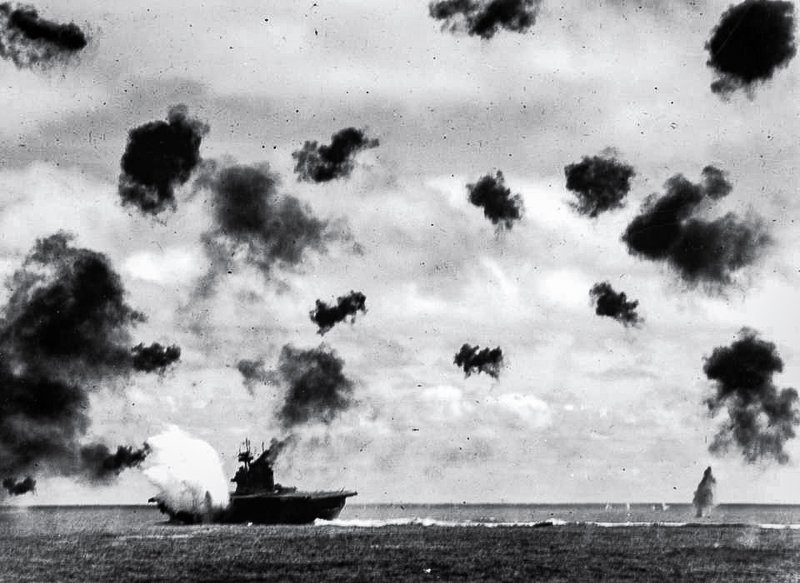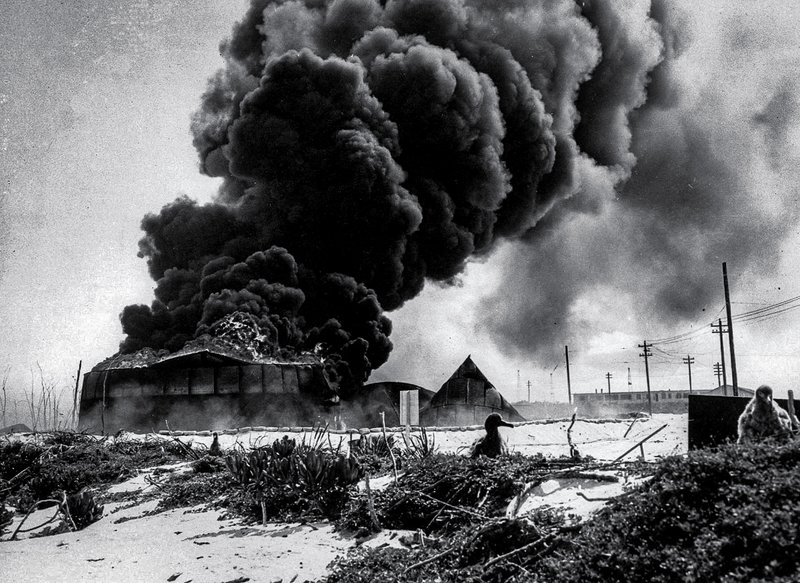
An SBD-3 dive bomber of Bombing Squadron Six, on the deck of USS Yorktown. The aircraft was flown by Ensign G.H. Goldsmith and ARM3c J. W. Patterson Jr. during the June 4, 1942, strike against the Japanese carrier Akagi. Note the battle damage on the tail. US Navy photo.
On the morning of June 4, 1942, Lt. Cmdr. Dick Best cranked on the engine of his Douglas SBD Dauntless dive bomber and raced off the flight deck of the USS Enterprise. The pilot climbed to 20,000 feet over the North Pacific Ocean, joining a massive fleet of American bombers, fighters, scouts, and torpedo planes bound for a remote string of islands known as Midway Atoll.
Midway, as the name suggests, is located roughly about halfway between Hawaii and Japan. The US Navy built an air station there in August 1941. Now, six months after the attacks on Pearl Harbor, a fleet of Japanese warships, including four aircraft carriers — the Akagi, the Kaga, the Hiryu, and the Soryu — were attempting an invasion of the island.
Best’s 18-plane bomber squadron descended to 14,000 feet as they approached the atoll. Up ahead, columns of thick black smoke rose into the sky, signaling that the Battle of Midway had begun.
The bombers flew into the fray and managed to reach their targets undetected. At that point, Best opened the dive flaps of his SBD Dauntless and pushed the twin throttles, pitching the plane into a 70-degree dive toward the Akagi with two other bombers on his flanks. The formation swooped down to an altitude of 2,000 feet and then dropped their payloads, blowing up the carrier’s flight deck, crippling its rudders, and destroying a handful of Japanese planes.

TBD-1 torpedo bombers of Torpedo Squadron Six unfold their wings on the deck of USS Enterprise prior to launching an attack against four Japanese carriers on the first day of the Battle of Midway. US Navy photo.
With the Akagi now effectively dead in the water, Best’s formation turned back toward the Enterprise as anti-aircraft fire erupted. All three planes were still fully intact when they landed on the flight deck. The rest of the squadron weren’t so lucky. Of the 18 bombers, 14 were either shot down, badly damaged, or forced to make emergency landings.
In the afternoon, Best returned to Midway on a second bombing raid — against Hiryu, the only one of the four Japanese carriers that survived the morning attack. This time, the Japanese were ready for them. “I had never seen such a continuous curtain of muzzle blasts,” Best recalled in an interview years later. Yet, despite the maelstrom of enemy fire, his formation managed to hit the Hiryu, igniting fires that sent her crew overboard and eventually caused the ship to sink.
For his role in the Battle of Midway, Best was awarded the Navy Cross. His and his comrades’ heroic actions that day would ultimately prove significant beyond the battle itself, as the stakes couldn’t have been higher.
Related: Profile of a Ship: USS Arizona
The Code-Breakers Who Made It Possible

The USS Yorktown is hit on the port side by a torpedo launched from a plane off the Japanese aircraft carrier Hiryu during the Battle of Midway on June 4, 1942. Photo courtesy of the National Archives and Records Administration.
The Japanese attack on Pearl Harbor dealt a devastating blow to the US Pacific Fleet. In its aftermath, the US Navy got to work improving its intelligence-gathering capabilities so that future attacks could be avoided.
To disseminate battle plans among its ranks, the Japanese Imperial Navy utilized an encrypted code known as JN-25B. According to the National Security Agency, the JN-25B codebook contained 27,500 numbered entries, plus an additional 300 pages of 100 randomized five-digit code groups. Of course, if the Allies managed to break the code, they would be able to gather crucial intelligence about operations the Japanese were planning.
The monumental task of decrypting JN-25B was given to a crack-shot team of US Navy cryptanalysts led by Lt. Cmdr. Thomas H. Dyer and Cmdr. Joe Rochefort. They were headquartered in the “dungeon” — aka, the basement — of the Station HYPO building in Pearl Harbor.
The codebreakers’ made their first big revelation in early 1942 after discovering Japanese plans that referred to the target of an upcoming attack as “AF.” To figure out the meaning of “AF,” the codebreakers instructed US forces stationed on Midway to transmit a phony report over the radio stating their fresh water system had malfunctioned. As anticipated, Japanese intelligence intercepted the message and then relayed the information in JN-25B, informing their superiors that “AF” was having problems with its fresh water system. And so, there it was: “AF” meant US Naval Air Station Midway.
The confirmation of Midway as the target of an impending Japanese offensive led US Navy Adm. Chester Nimitz to stage a fleet of aircraft carriers within striking range of Midway. Hence, on June 4, 1942, the American dive-bombers from the USS Enterprise, USS Hornet, and USS Yorktown were able to strike just as soon as the Japanese Zeros landed on the four carriers to rearm and refuel following their initial attack.
Related: The American Aviator Who Crash-Landed Into a Soccer Game, Then Stopped For Beers While Evading Nazis
What Was the Significance of the Battle of Midway?

Black smoke rises from a burning US oil tank, set afire during a Japanese air raid on Naval Air Station Midway on Midway Atoll, on June 4, 1942. American forces maintained an airstrip with dozens of aircraft stationed on the tiny island. The attack inflicted heavy damage, but the airstrip was still usable. Photo courtesy of the National Archives and Records Administration.
The Japanese attack on Midway was intended to be a death blow to the US Pacific Fleet. A successful invasion would not only have left the American Navy in tatters — it would have also allowed Japan to establish a stronghold within striking distance of Hawaii.
Suffice it to say that the plan completely backfired. In the four-day battle, the Japanese lost four aircraft carriers (all on the first day), one cruiser, hundreds of aircraft, and approximately 3,057 men, including more than 200 of their best pilots. The Americans lost the Yorktown, 145 aircraft, a destroyer, and approximately 360 service members.
Japan’s defeat in the Battle of Midway crushed morale among its troops as it marked the end of their military dominance in the Pacific. Its momentum lost, Japan relinquished its plans for future attacks on American soil and assumed a defensive posture. Meanwhile, the Allies went on the offensive with an aggressive island-hopping campaign that achieved a series of victories in Tarawa, Peleliu, Saipan, Guam, Iwo Jima, and Okinawa. The Allies didn’t relent until Japan surrendered, following the nuclear attacks on Hiroshima and Nagasaki.
Read Next: World War II Veterans Share Their Stories at Pearl Harbor

Matt Fratus is a history staff writer for Coffee or Die. He prides himself on uncovering the most fascinating tales of history by sharing them through any means of engaging storytelling. He writes for his micro-blog @LateNightHistory on Instagram, where he shares the story behind the image. He is also the host of the Late Night History podcast. When not writing about history, Matt enjoys volunteering for One More Wave and rooting for Boston sports teams.
BRCC and Bad Moon Print Press team up for an exclusive, limited-edition T-shirt design!
BRCC partners with Team Room Design for an exclusive T-shirt release!
Thirty Seconds Out has partnered with BRCC for an exclusive shirt design invoking the God of Winter.
Lucas O'Hara of Grizzly Forge has teamed up with BRCC for a badass, exclusive Shirt Club T-shirt design featuring his most popular knife and tiomahawk.
Coffee or Die sits down with one of the graphic designers behind Black Rifle Coffee's signature look and vibe.
Biden will award the Medal of Honor to a Vietnam War Army helicopter pilot who risked his life to save a reconnaissance team from almost certain death.
Ever wonder how much Jack Mandaville would f*ck sh*t up if he went back in time? The American Revolution didn't even see him coming.
A nearly 200-year-old West Point time capsule that at first appeared to yield little more than dust contains hidden treasure, the US Military Academy said.












